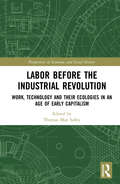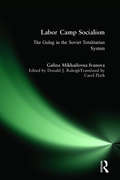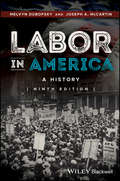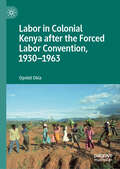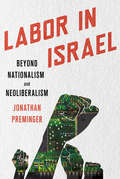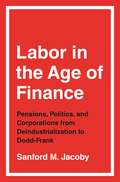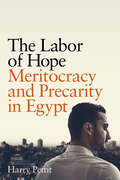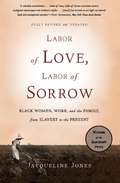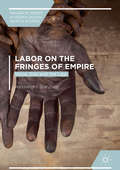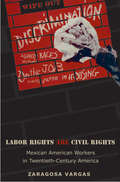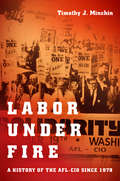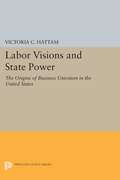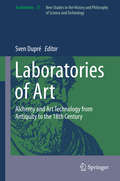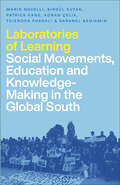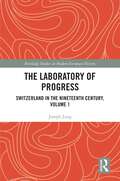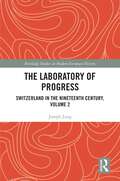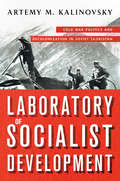- Table View
- List View
Labor Before the Industrial Revolution: Work, Technology and their Ecologies in an Age of Early Capitalism (Perspectives in Economic and Social History)
by Edited by Thomas Max SafleyOne cannot conceive of capitalism without labor. Yet many of the current debates about economic development leading to industrialization fail to directly engage with labor at all. This collection of essays strives to correct this oversight and to reintroduce labor into the great debates about capitalist development and economic growth before the Industrial Revolution. By attending to the effects of specific regulatory, technological, social and physical environments on producers and production in a set of specific industries, these essays use an “ecological” approach that demonstrates how productivity, knowledge and regime changed between 1400 and 1800. This book will be of interest to researchers in history, especially labor history, and European economic development.
Labor Before the Industrial Revolution: Work, Technology and their Ecologies in an Age of Early Capitalism (Perspectives in Economic and Social History)
One cannot conceive of capitalism without labor. Yet many of the current debates about economic development leading to industrialization fail to directly engage with labor at all. This collection of essays strives to correct this oversight and to reintroduce labor into the great debates about capitalist development and economic growth before the Industrial Revolution. By attending to the effects of specific regulatory, technological, social and physical environments on producers and production in a set of specific industries, these essays use an “ecological” approach that demonstrates how productivity, knowledge and regime changed between 1400 and 1800. This book will be of interest to researchers in history, especially labor history, and European economic development.
Labor Camp Socialism: The Gulag in the Soviet Totalitarian System
by Donald J. Raleigh Galina Mikhailovna Ivanova Galina Mikhailovna Carol A. FlathThis is the first historical survey of the Gulag based on newly accessible archival sources as well as memoirs and other studies published since the beginning of glasnost.Over the course of several decades, the Soviet labor camp system drew into its orbit tens of millions of people -- political prisoners and their families, common criminals, prisoners of war, internal exiles, local officials, and prison camp personnel. This study sheds new light on the operation of the camp system, both internally and as an integral part of a totalitarian regime that "institutionalized violence as a universal means of attaining its goals". In Galina Ivanova's unflinching account -- all the more powerful for its austerity -- the Gulag is the ultimate manifestation of a more pervasive and lasting distortion of the values of legality, labor, and life that burdens Russia to the present day.
Labor Camp Socialism: The Gulag in the Soviet Totalitarian System (The\new Russian History Ser.)
by Donald J. Raleigh Galina Mikhailovna Ivanova Galina Mikhailovna Carol A. FlathThis is the first historical survey of the Gulag based on newly accessible archival sources as well as memoirs and other studies published since the beginning of glasnost.Over the course of several decades, the Soviet labor camp system drew into its orbit tens of millions of people -- political prisoners and their families, common criminals, prisoners of war, internal exiles, local officials, and prison camp personnel. This study sheds new light on the operation of the camp system, both internally and as an integral part of a totalitarian regime that "institutionalized violence as a universal means of attaining its goals". In Galina Ivanova's unflinching account -- all the more powerful for its austerity -- the Gulag is the ultimate manifestation of a more pervasive and lasting distortion of the values of legality, labor, and life that burdens Russia to the present day.
Labor in America: A History
by Melvyn Dubofsky Joseph A. McCartinThis book, designed to give a survey history of American labor from colonial times to the present, is uniquely well suited to speak to the concerns of today’s teachers and students. As issues of growing inequality, stagnating incomes, declining unionization, and exacerbated job insecurity have increasingly come to define working life over the last 20 years, a new generation of students and teachers is beginning to seek to understand labor and its place and ponder seriously its future in American life. Like its predecessors, this ninth edition of our classic survey of American labor is designed to introduce readers to the subject in an engaging, accessible way.
Labor in America: A History
by Melvyn Dubofsky Joseph A. McCartinThis book, designed to give a survey history of American labor from colonial times to the present, is uniquely well suited to speak to the concerns of today’s teachers and students. As issues of growing inequality, stagnating incomes, declining unionization, and exacerbated job insecurity have increasingly come to define working life over the last 20 years, a new generation of students and teachers is beginning to seek to understand labor and its place and ponder seriously its future in American life. Like its predecessors, this ninth edition of our classic survey of American labor is designed to introduce readers to the subject in an engaging, accessible way.
Labor in Colonial Kenya after the Forced Labor Convention, 1930–1963
by Opolot OkiaThis book advances research into the government-forced labor used widely in colonial Kenya from 1930 to 1963 after the passage of the International Labor Organization’s Forced Labour Convention. While the 1930 Convention intended to mark the suppression of forced labor practices, various exemptions meant that many coercive labor practices continued in colonial territories. Focusing on East Africa and the Kenya Colony, this book shows how the colonial administration was able to exploit the exemption clause for communal labor, thus ensuring the mobilization of African labor for infrastructure development. As an exemption, communal labor was not defined as forced labor but instead justified as a continuation of traditional African and community labor practices. Despite this ideological justification, the book shows that communal labor was indeed an intensification of coercive labor practices and one that penalized Africans for non-compliance with fines or imprisonment. The use of forced labor before and after the passage of the Convention is examined, with a focus on its use during World War II as well as in efforts to combat soil erosion in the rural African reserve areas in Kenya. The exploitation of female labor, the Mau Mau war of the 1950s, civilian protests, and the regeneration of communal labor as harambee after independence are also discussed.
Labor in Israel: Beyond Nationalism and Neoliberalism
by Jonathan PremingerUsing a comprehensive analysis of the wave of organizing that swept the country starting in 2007, Labor in Israel investigates the changing political status of organized labor in the context of changes to Israel’s political economy, including liberalization, the rise of non-union labor organizations, the influx of migrant labor, and Israel’s complex relations with the Palestinians. Through his discussion of organized labor’s relationship to the political community and its nationalist political role, Preminger demonstrates that organized labor has lost the powerful status it enjoyed for much of Israel’s history. Despite the weakening of trade unions and the Histadrut, however, he shows the ways in which the fragmentation of labor representation has created opportunities for those previously excluded from the labor movement regime.Organized labor is now trying to renegotiate its place in contemporary Israel, a society that no longer accepts labor’s longstanding claim to be the representative of the people. As such, Preminger concludes that organized labor in Israel is in a transitional and unsettled phase in which new marginal initiatives, new organizations, and new alliances that have blurred the boundaries of the sphere of labor have not yet consolidated into clear structures of representation or accepted patterns of political interaction.
Labor in the Age of Finance: Pensions, Politics, and Corporations from Deindustrialization to Dodd-Frank
by Sanford M. JacobyFrom award-winning economic historian Sanford M. Jacoby, a fascinating and important study of the labor movement and shareholder capitalismSince the 1970s, American unions have shrunk dramatically, as has their economic clout. Labor in the Age of Finance traces the search for new sources of power, showing how unions turned financialization to their advantage.Sanford Jacoby catalogs the array of allies and finance-based tactics labor deployed to stanch membership losses in the private sector. By leveraging pension capital, unions restructured corporate governance around issues like executive pay and accountability. In Congress, they drew on their political influence to press for corporate reforms in the wake of business scandals and the financial crisis. The effort restrained imperial CEOs but could not bridge the divide between workers and owners. Wages lagged behind investor returns, feeding the inequality identified by Occupy Wall Street. And labor’s slide continued.A compelling blend of history, economics, and politics, Labor in the Age of Finance explores the paradox of capital bestowing power to labor in the tumultuous era of Enron, Lehman Brothers, and Dodd-Frank.
Labor in the Age of Finance: Pensions, Politics, and Corporations from Deindustrialization to Dodd-Frank
by Sanford M. JacobyFrom award-winning economic historian Sanford M. Jacoby, a fascinating and important study of the labor movement and shareholder capitalismSince the 1970s, American unions have shrunk dramatically, as has their economic clout. Labor in the Age of Finance traces the search for new sources of power, showing how unions turned financialization to their advantage.Sanford Jacoby catalogs the array of allies and finance-based tactics labor deployed to stanch membership losses in the private sector. By leveraging pension capital, unions restructured corporate governance around issues like executive pay and accountability. In Congress, they drew on their political influence to press for corporate reforms in the wake of business scandals and the financial crisis. The effort restrained imperial CEOs but could not bridge the divide between workers and owners. Wages lagged behind investor returns, feeding the inequality identified by Occupy Wall Street. And labor’s slide continued.A compelling blend of history, economics, and politics, Labor in the Age of Finance explores the paradox of capital bestowing power to labor in the tumultuous era of Enron, Lehman Brothers, and Dodd-Frank.
The Labor of Hope: Meritocracy and Precarity in Egypt
by Harry PettitTechnological advancements, expanding education, and unfettered capitalism have encouraged many around the world to aspire to better lives, even as declines in employment and widening inequality are pushing more and more people into insecurity and hardship. In Egypt, a generation of young men desire fulfilling employment, meaningful relationships, and secure family life, yet find few paths to achieve this. The Labor of Hope follows these educated but underemployed men as they struggle to establish careers and build satisfying lives. In so doing, this book reveals the lived contradiction at the heart of capitalist systems—the expansive dreams they encourage and the precarious lives they produce. Harry Pettit follows young men as they engage a booming training, recruitment, and entrepreneurship industry that sells the cruel meritocratic promise that a good life is realizable for all. He considers the various ways individuals cultivate distraction and hope for future mobility: education, migration, consumption, and prayer. These hope-filled practices are a form of emotional labor for young men, placing responsibility on the individual rather than structural issues in Egypt's economy. Illuminating this emotional labor, Pettit shows how the capitalist economy continues to capture the attention of the very people harmed by it.
The Labor of Hope: Meritocracy and Precarity in Egypt
by Harry PettitTechnological advancements, expanding education, and unfettered capitalism have encouraged many around the world to aspire to better lives, even as declines in employment and widening inequality are pushing more and more people into insecurity and hardship. In Egypt, a generation of young men desire fulfilling employment, meaningful relationships, and secure family life, yet find few paths to achieve this. The Labor of Hope follows these educated but underemployed men as they struggle to establish careers and build satisfying lives. In so doing, this book reveals the lived contradiction at the heart of capitalist systems—the expansive dreams they encourage and the precarious lives they produce. Harry Pettit follows young men as they engage a booming training, recruitment, and entrepreneurship industry that sells the cruel meritocratic promise that a good life is realizable for all. He considers the various ways individuals cultivate distraction and hope for future mobility: education, migration, consumption, and prayer. These hope-filled practices are a form of emotional labor for young men, placing responsibility on the individual rather than structural issues in Egypt's economy. Illuminating this emotional labor, Pettit shows how the capitalist economy continues to capture the attention of the very people harmed by it.
Labor of Love, Labor of Sorrow: Black Women, Work, and the Family, from Slavery to the Present
by Jacqueline JonesThe forces that shaped the institution of slavery in the American South endured, albeit in altered form, long after slavery was abolished. Toiling in sweltering Virginia tobacco factories or in the kitchens of white families in Chicago, black women felt a stultifying combination of racial discrimination and sexual prejudice. And yet, in their efforts to sustain family ties, they shared a common purpose with wives and mothers of all classes.In Labor of Love, Labor of Sorrow, historian Jacqueline Jones offers a powerful account of the changing role of black women, lending a voice to an unsung struggle from the depths of slavery to the ongoing fight for civil rights.
Labor of Love, Labor of Sorrow: Black Women, Work, and the Family, from Slavery to the Present
by Jacqueline JonesThe forces that shaped the institution of slavery in the American South endured, albeit in altered form, long after slavery was abolished. Toiling in sweltering Virginia tobacco factories or in the kitchens of white families in Chicago, black women felt a stultifying combination of racial discrimination and sexual prejudice. And yet, in their efforts to sustain family ties, they shared a common purpose with wives and mothers of all classes.In Labor of Love, Labor of Sorrow, historian Jacqueline Jones offers a powerful account of the changing role of black women, lending a voice to an unsung struggle from the depths of slavery to the ongoing fight for civil rights.
Labor on the Fringes of Empire: Voice, Exit and the Law (PDF) (Palgrave Series in Indian Ocean World Studies)
by Alessandro StanzianiAfter the abolition of slavery in the Indian Ocean and Africa, the world of labor remained unequal, exploitative, and violent, straddling a fine line between freedom and unfreedom. This book explains why. Unseating the Atlantic paradigm of bondage and drawing from a rich array of colonial, estate, plantation and judicial archives, Alessandro Stanziani investigates the evolution of labor relationships on the Indian subcontinent, the Indian Ocean and Africa, with case studies on Assam, the Mascarene Islands and the French Congo. He finds surprising relationships between African and Indian abolition movements and European labor practices, inviting readers to think in terms of trans-oceanic connections rather than simple oppositions. Above all, he considers how the meaning and practices of freedom in the colonial world differed profoundly from those in the mainland. Arguing for a multi-centered view of imperial dynamics, Labor on the Fringes of Empire is a pioneering global history of nineteenth-century labor.
Labor Rights Are Civil Rights: Mexican American Workers in Twentieth-Century America
by Zaragosa VargasIn 1937, Mexican workers were among the strikers and supporters beaten, arrested, and murdered by Chicago policemen in the now infamous Republic Steel Mill Strike. Using this event as a springboard, Zaragosa Vargas embarks on the first full-scale history of the Mexican-American labor movement in twentieth-century America. Absorbing and meticulously researched, Labor Rights Are Civil Rightspaints a multifaceted portrait of the complexities and contours of the Mexican American struggle for equality from the 1930s to the postwar era. Drawing on extensive archival research, Vargas focuses on the large Mexican American communities in Texas, Colorado, and California. As he explains, the Great Depression heightened the struggles of Spanish speaking blue-collar workers, and employers began to define citizenship to exclude Mexicans from political rights and erect barriers to resistance. Mexican Americans faced hostility and repatriation. The mounting strife resulted in strikes by Mexican fruit and vegetable farmers. This collective action, combined with involvement in the Communist party, led Mexican workers to unionize. Vargas carefully illustrates how union mobilization in agriculture, tobacco, garment, and other industries became an important vehicle for achieving Mexican American labor and civil rights. He details how interracial unionism proved successful in cross-border alliances, in fighting discriminatory hiring practices, in building local unions, in mobilizing against fascism and in fighting brutal racism. No longer willing to accept their inferior status, a rising Mexican American grassroots movement would utilize direct action to achieve equality.
Labor Under Fire: A History of the AFL-CIO since 1979
by Timothy J. MinchinFrom the Reagan years to the present, the labor movement has faced a profoundly hostile climate. As America's largest labor federation, the AFL-CIO was forced to reckon with severe political and economic headwinds. Yet the AFL-CIO survived, consistently fighting for programs that benefited millions of Americans, including social security, unemployment insurance, the minimum wage, and universal health care. With a membership of more than 13 million, it was also able to launch the largest labor march in American history--1981's Solidarity Day--and to play an important role in politics.In a history that spans from 1979 to the present, Timothy J. Minchin tells a sweeping, national story of how the AFL-CIO sustained itself and remained a significant voice in spite of its powerful enemies and internal constraints. Full of details, characters, and never-before-told stories drawn from unexamined, restricted, and untapped archives, as well as interviews with crucial figures involved with the organization, this book tells the definitive history of the modern AFL-CIO.
Labor Visions and State Power: The Origins of Business Unionism in the United States
by Victoria C. HattamWhy has labor played a more limited role in national politics in the United States than it has in other advanced industrial societies? Victoria Hattam demonstrates that voluntarism, as American labor's policy was known, was the American Federation of Labor's strategic response to the structure of the American state, particularly to the influence of American courts. The AFL's strategic calculation was not universal, however. This book reveals the competing ideologies and acts of interpretation that produced these variations in state-labor relations.Originally published in 1993.The Princeton Legacy Library uses the latest print-on-demand technology to again make available previously out-of-print books from the distinguished backlist of Princeton University Press. These editions preserve the original texts of these important books while presenting them in durable paperback and hardcover editions. The goal of the Princeton Legacy Library is to vastly increase access to the rich scholarly heritage found in the thousands of books published by Princeton University Press since its founding in 1905.
Laboratories of Art: Alchemy and Art Technology from Antiquity to the 18th Century (Archimedes #37)
by Sven DupréThis book explores the interconnections and differentiations between artisanal workshops and alchemical laboratories and between the arts and alchemy from Antiquity to the eighteenth century. In particular, it scrutinizes epistemic exchanges between producers of the arts and alchemists. In the fifteenth and sixteenth centuries the term laboratorium uniquely referred to workplaces in which ‘chemical’ operations were performed: smelting, combustion, distillation, dissolution and precipitation. Artisanal workshops equipped with furnaces and fire in which ‘chemical’ operations were performed were also known as laboratories. Transmutational alchemy (the transmutation of all base metals into more noble ones, especially gold) was only one aspect of alchemy in the early modern period. The practice of alchemy was also about the chemical production of things--medicines, porcelain, dyes and other products as well as precious metals and about the knowledge of how to produce them. This book uses examples such as the Uffizi to discuss how Renaissance courts established spaces where artisanal workshops and laboratories were brought together, thus facilitating the circulation of materials, people and knowledge between the worlds of craft (today’s decorative arts) and alchemy. Artisans became involved in alchemical pursuits beyond a shared material culture and some crafts relied on chemical expertise offered by scholars trained as alchemists. Above all, texts and books, products and symbols of scholarly culture played an increasingly important role in artisanal workshops. In these workplaces a sort of hybrid figure was at work. With one foot in artisanal and the other in scholarly culture this hybrid practitioner is impossible to categorize in the mutually exclusive categories of scholar and craftsman. By the seventeenth century the expertise of some glassmakers, silver and goldsmiths and producers of porcelain was just as based in the worlds of alchemical and bookish learning as it was grounded in hands-on work in the laboratory. This book suggests that this shift in workshop culture facilitated the epistemic exchanges between alchemists and producers of the decorative arts.
Laboratories of Learning: Social Movements, Education and Knowledge-Making in the Global South
by Mario Novelli Birgul Kutan Patrick Kane Adnan Celik Tejendra Pherali Saranel Benjamin‘Outstanding ... This book is a must-read for scholars and activists interested in the impact of grassroots knowledge-making on individuals, institutions and society’ -- Rebecca Tarlau, author of Occupying Schools, Occupying Land‘In social movements, people [learn how to] re-imagine their worlds. This powerful and inspiring book shows that movement education is not a luxury but a central part of effective struggle’ -- Laurence Cox, author of Why Social Movements MatterLaboratories of Learning proves, through exploring inspiring social movements around the world, that the education and knowledge-making happening inside these movements is crucial for the future of social justice for all. It asks three simple but profound questions: How do movements learn and make knowledge? What kinds of knowledge do movements make? And what is its effect on individual activists, movements and even whole societies? Written in collaboration with leading activists from different movements in Turkey, Colombia, Nepal and South Africa, each case shows that these activists in the Global South can offer exciting insights into the myriad of ways that movements learn and produce knowledge as they struggle for a better world.Designed to inspire and innovate, Laboratories of Learning is an opportunity for activists to learn new, ground-breaking ideas, born out of moments working at the intersection of theory and practice, pushing the boundaries of new thinking and the limits of the possible.Mario Novelli is Professor in the Political Economy of Education at the University of Sussex. Birgül Kutan is a Lecturer at the Centre for International Education, University of Sussex. Patrick Kane is based in Cali, Colombia and has been engaged in international solidarity work for over fifteen years. Adnan Çelik is a postdoctoral researcher at the Institute for Advanced Study in the Humanities (KWI), Universität Duisburg-Essen, Germany. Tejendra Pherali is Professor of Education, Conflict and Peace at the IOE, at University College London. Saranel Benjamin is a development practitioner, and Co-Executive Director of Mama Cash.
The Laboratory of Progress: Switzerland in the Nineteenth Century, Volume 1 (Routledge Studies in Modern European History #93)
by Joseph JungThe Laboratory of Progress: Switzerland in the 19th Century tells the improbable story of how a small, backward, mountainous agricultural country with almost no raw materials became an industrial powerhouse, a hub of innovation, a touristic mecca and a pioneer in transportation – all in the course of a single century. That a tiny landlocked country should become a dominant steamship builder for the rest of the world; that a country that had never seen a cotton plant should become the world’s second-largest textile producer; that a country with hardly any level terrain should come to boast the world’s most highly developed railway network; and that a country whose main export was impoverished emigrants should be transformed into one of the world’s major financial centres – these astonishing developments, among many others, are explored and explained, both through the specific stories of individual innovators and through a prescient analysis of the political, economic, societal and cultural structures that formed the context in which Switzerland’s astonishing transformation took place. The book is a compelling read both for professional historians and for general readers with an interest in Switzerland; it highlights the roles of transport networks and individual pioneers in industrial and political development.
The Laboratory of Progress: Switzerland in the Nineteenth Century, Volume 1 (Routledge Studies in Modern European History #93)
by Joseph JungThe Laboratory of Progress: Switzerland in the 19th Century tells the improbable story of how a small, backward, mountainous agricultural country with almost no raw materials became an industrial powerhouse, a hub of innovation, a touristic mecca and a pioneer in transportation – all in the course of a single century. That a tiny landlocked country should become a dominant steamship builder for the rest of the world; that a country that had never seen a cotton plant should become the world’s second-largest textile producer; that a country with hardly any level terrain should come to boast the world’s most highly developed railway network; and that a country whose main export was impoverished emigrants should be transformed into one of the world’s major financial centres – these astonishing developments, among many others, are explored and explained, both through the specific stories of individual innovators and through a prescient analysis of the political, economic, societal and cultural structures that formed the context in which Switzerland’s astonishing transformation took place. The book is a compelling read both for professional historians and for general readers with an interest in Switzerland; it highlights the roles of transport networks and individual pioneers in industrial and political development.
The Laboratory of Progress: Switzerland in the Nineteenth Century, Volume 2 (Routledge Studies in Modern European History #96)
by Joseph JungThe Laboratory of Progress: Switzerland in the 19th Century tells the improbable story of how a small, backward, mountainous agricultural country with almost no raw materials became an industrial powerhouse, a hub of innovation, a touristic mecca and a pioneer in transportation – all in the course of a single century. That a tiny landlocked country should become a dominant steamship builder for the rest of the world; that a country that had never seen a cotton plant should become the world’s second-largest textile producer; that a country with hardly any level terrain should come to boast the world’s most highly developed railway network; and that a country whose main export was impoverished emigrants should be transformed into one of the world’s major financial centres – these astonishing developments, among many others, are explored and explained, both through the specific stories of individual innovators and through a prescient analysis of the political, economic, societal and cultural structures that formed the context in which Switzerland’s astonishing transformation took place. The book is a compelling read both for professional historians and for general readers with an interest in Switzerland; it highlights the roles of transport networks and individual pioneers in industrial and political development.
The Laboratory of Progress: Switzerland in the Nineteenth Century, Volume 2 (Routledge Studies in Modern European History #96)
by Joseph JungThe Laboratory of Progress: Switzerland in the 19th Century tells the improbable story of how a small, backward, mountainous agricultural country with almost no raw materials became an industrial powerhouse, a hub of innovation, a touristic mecca and a pioneer in transportation – all in the course of a single century. That a tiny landlocked country should become a dominant steamship builder for the rest of the world; that a country that had never seen a cotton plant should become the world’s second-largest textile producer; that a country with hardly any level terrain should come to boast the world’s most highly developed railway network; and that a country whose main export was impoverished emigrants should be transformed into one of the world’s major financial centres – these astonishing developments, among many others, are explored and explained, both through the specific stories of individual innovators and through a prescient analysis of the political, economic, societal and cultural structures that formed the context in which Switzerland’s astonishing transformation took place. The book is a compelling read both for professional historians and for general readers with an interest in Switzerland; it highlights the roles of transport networks and individual pioneers in industrial and political development.
Laboratory of Socialist Development: Cold War Politics and Decolonization in Soviet Tajikistan
by Artemy M. KalinovskyArtemy Kalinovsky’s Laboratory of Socialist Development investigates the Soviet effort to make promises of decolonization a reality by looking at the politics and practices of economic development in central Asia between World War II and the collapse of the Soviet Union. Focusing on the Tajik Soviet Socialist Republic, Kalinovsky places the Soviet development of central Asia in a global context.Connecting high politics and intellectual debates with the life histories and experiences of peasants, workers, scholars, and engineers, Laboratory of Socialist Development shows how these men and women negotiated Soviet economic and cultural projects in the decades following Stalin’s death. Kalinovsky’s book investigates how people experienced new cities, the transformation of rural life, and the building of the world’s tallest dam. Kalinovsky connects these local and individual moments to the broader context of the Cold War, shedding new light on how paradigms of development change over time. Throughout the book, he offers comparisons with experiences in countries such as India, Iran, and Afghanistan, and considers the role of intermediaries who went to those countries as part of the Soviet effort to spread its vision of modernity to the postcolonial world.Laboratory of Socialist Development offers a new way to think about the post-war Soviet Union, the relationship between Moscow and its internal periphery, and the interaction between Cold War politics and domestic development. Kalinovsky’s innovative research pushes readers to consider the similarities between socialist development and its more familiar capitalist version.
